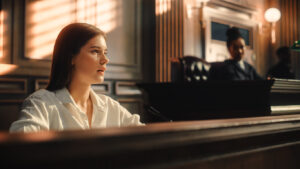
If you were injured in an accident caused by someone’s negligence, you can seek financial compensation from the party responsible.
To claim damages, however, injured victims have the initial burden of proof to support the personal injury claim with evidence.
Your evidence must be persuasive enough to meet the burden of proof standard that applies to your case.
What Is a Burden of Proof?

In personal injury cases, including those based on negligence, the injured victim, known as the plaintiff, has a burden of proof to support their claims with evidence. The burden of proof in a personal injury case is “preponderance of the evidence.”
What is a preponderance of the evidence? Simply, this means it must be more likely than not that the other party caused your damages. If a jury or judge finds that chances are more than 50% that the defendant’s actions (or inaction) caused the accident, they can find liability is established and move on to considering monetary damages.
In criminal cases, on the contrary, the burden of proof at trial is “beyond a reasonable doubt.” This is a much higher burden of proof and means close to 100% certainty.
A third burden of proof standard used in certain cases is called “clear and convincing evidence.” This standard might apply if you are asking for punitive damages in a personal injury case. The clear and convincing standard is stronger than preponderance of the evidence but not as demanding as the reasonable doubt standard.
Elements of a Negligence Claim

Personal injury cases are typically based on a negligence cause of action. Four legal elements must be shown by a plaintiff in order to prove negligence:
- Duty of care: A duty of care involves the responsibility we have to act in ways that are reasonably safe to prevent harm to others. This means taking steps to avoid foreseeable problems. For example, driving through a red light creates a foreseeable risk of injury to other people. Stopping at red lights and obeying traffic signals are ways that we follow our duties of care to others.
- Breach of duty: When someone fails to act as a reasonable person would have or should have done, that can be considered a breach of duty. An example would be a store owner failing to replace a broken step in front of their store when they know it is broken. If someone later falls and is injured due to the step, the business owner breached their duty of care.
- Cause: Personal injury plaintiffs need to prove that the defendant’s breach of duty caused their injuries. There can not be a different cause for the accident. A plaintiff must show that “but for” the act or failure to act by the accused party, the injured victim would not have been hurt. If there was some intervening or separate cause for a victim’s injuries, the defendant could be found not liable.
- Damages: Plaintiffs in a personal injury case must also show they suffered damages due to the defendant’s conduct. Damages must be real–they can not be speculative or imagined. Most personal injury cases involve two types of damages: economic damages (such as medical bills, property damage, lost income, and out-of-pocket costs) and non-economic damages, which can include mental anguish or pain and suffering.
These four elements are the cornerstones of most personal injury cases involving negligence. In some cases, however, strict liability could apply. This means a defendant could be found responsible without proof of negligence or intentional conduct.
Examples of strict liability cases can be dog bite incidents, product liability claims, or engaging in abnormally dangerous activities.
What Evidence Can Plaintiffs Use To Meet Their Burden of Proof?
To show negligence in a personal injury case and meet the required burden of proof, an accident victim will rely on evidence that can be admitted in court. Some examples of evidence used to meet the burden of proof include:
- Documentation: Medical bills, medical records, invoices for property repairs, proof of lost income, expert reports, and other professionally-produced documentation of the harm caused can be brought in as evidence in your claim.
- Accident scene evidence: This type of evidence can include photos from a crash site, physical evidence, video recordings, eyewitness statements, and other firsthand evidence of how the accident happened. Plaintiffs and their attorneys must act quickly to collect evidence and build the foundation of their case.
- Expert testimony: Doctors, therapists, and experienced crash scene investigators can act as experts and help a jury understand what happened. Experienced personal injury lawyers will know what experts they can contact to strengthen your claim and pursue the maximum payment for your losses.
The evidence in your claim will be unique to your case. Your lawyer will help you navigate the process and advance your case to meet the burden of proof.
An Experienced Savannah Personal Injury Attorney Can Help You Meet Your Burden of Proof
A successful case strategy will be based on meeting the burden of proof that applies to the case. Every step is crucial to maximize an injured victim’s financial recovery. Our skilled and experienced Savannah personal injury lawyers at Bowen Painter Injury Lawyers will work hard to help you meet your burden of proof after you experience an accident in Georgia. Call us today to schedule a free consultation at (912) 335-1909.

